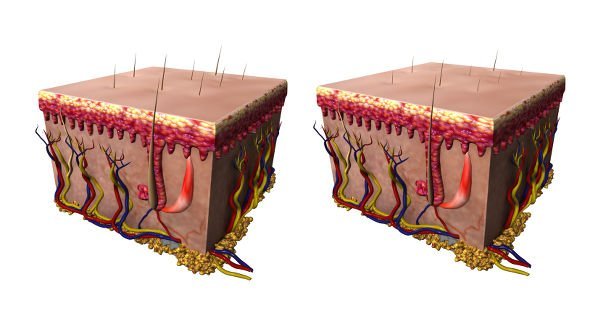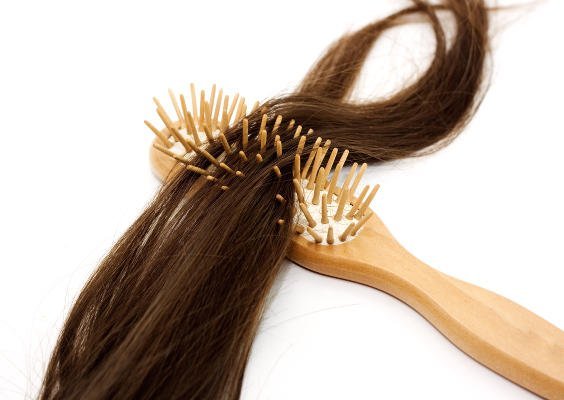Female pattern hair loss is the most common cause of hair loss in women. This aesthetic problem is common in women aged 30 to 50 and can cause highly negative psychological experiences. Combination treatment for female pattern hair loss helps to slow down hair loss and achieve greater vitality in the hair follicle.

IML's combination treatments improve intense diffuse alopecia
Female pattern hair loss, Female pattern hair loss (FPHL) or diffuse alopecia is the most common cause of baldness in women.
It consists of centripetal hair loss, characterised by miniaturisation of the hair follicle. This cause thinning of the hair, preserving the hairline. In most of the cases there is no total hair loss, as opposed to male pattern baldness.
The characteristics of female pattern hair loss are:

One of the characteristics of female pattern diffuse alopecia is hair miniaturisation
Female pattern hair loss does not appear at any predictable age. It can appear in puberty, although it is more common in the age group of 30 to 50 years.
This aesthetic problem in women can cause a major psychological impact, in many case accompanied by anxiety, since it is experienced by:
Female pattern hair loss can be caused by the following:
Female pattern diffuse alopecia pathogen is still unclear. However, we have verified that it responds to certain pharmacological and local treatments.
Differential diagnosis is essential in treating female diffuse alopecia, since other causes of alopecia must be discarded. These include:
Our dermatologists or hair surgeons will order blood work to study the biochemical (nutritional), endocrine (hormonal) and immunological parameters to act on the cause of the problem.

Differential diagnosis is key in treating female alopecia
Intense diffuse alopecia is treated at IML with a combination of 4 techniques:
This is a light treatment that prevents the thermal effect and facilitates photo stimulation.
The cellular organelles involved in these responses are mitochondria, acting on the C oxidase cytochrome, that can increase transcription of factors that activate genes, which at the same time, produce proteins useful to the cells, with increase in cell proliferation and migration and a rise in growth factor production.
This originates stimulation of hair re-entering the anagen stage, and foreseeably, the catagen stage.
The wavelength applied is between 635 and 655 nm and can be coherent light (laser) or non-coherent light (LED).
In general, 10 to 20 LLLT sessions are recommended.
Growth factors is a concentration of growth factors extracted from the patient's own blood.
These growth factors induce an increase in cellular metabolism rates, such as multiplication and migration of fibroblasts, collagen stimulation and stem cell activation, all of which benefit the hair follicles.
Growth factor functions are:
Growth factors is obtained by centrifuging a sample of the patient's blood. In the centrifuge process, the different components or blood fractions are separated. The fraction rich in growth factors is extracted and infiltrated through injections to the top of the head, where hair thinning and loss is caused.
An average of 3 sessions, at intervals of 2 or 3 weeks are recommended.

Combined Protocol for Diffuse Female Alopecia reduces the rate of hair loss
Carboxytherapy consists of infiltrating micro-injections of CO2 into the scalp.
The CO2 penetrates the conjunctive tissue, increasing blood flow and stimulating capillary vasodilation. This improvement in microcirculation in the area stimulates nutrient and oxygen supply to the hair follicle.
The dosimetry applied in alopecia treatment is 5 ml CO2 per puncture.
Four to ten sessions are recommended.
Capillary mesotherapy consists of infiltration of a combination of effective substances against alopecia into the scalp:
The procedure consists of micro-puncture applications with an average density of 0.2 ml per puncture, using a total of 5 to 10 ml solution per session, depending on the severity of the alopecia and the extent of treatment.
Four to ten sessions are recommended.
The average sessions for combined treatment for diffuse intense alopecia are as follows:
10 LLLT + 3 Growth factors + 4 Mesotherapy + 4 Carboxytherapy
Average duration of the treatment for diffuse intense alopecia is 11 weeks, distributed as follows:
| Week | Treatment | Treatment |
|---|---|---|
| 1 | Growth F. | LLLT |
| 2 | Meso | LLLT |
| 3 | Carbo | LLLT |
| 4 | Growth F. | LLLT |
| 5 | Meso | LLLT |
| 6 | Carbo | LLLT |
| 7 | Meso | LLLT |
| 8 | Growth F. | LLLT |
| 9 | Carbo | LLLT |
| 10 | Meso | LLLT |
| 11 | Carbo | LLLT |
In most cases, the combination of IML treatments for diffuse intense alopecia generate the following outcomes:
Results as far as increased hair calibre are observed in approximately 6 months, given that the hair needs time to grow, therefore this improvement is not noticeable immediately after the treatment ends.
Our capillary surgeons are experts in treating alopecia. Request a free informative consultation now with one of our specialists.